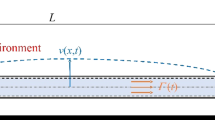Abstract
An experimental study has been carried out to investigate the flow in the KAIST shock tunnel with two moving throat plugs at a primary shock velocity of 1.19 km/s. The nozzle reservoir pressure and the Pitot pressure at the exit of the nozzle were measured to examine the influence of the moving throat plugs on the shock tunnel flow. To assess the present experimental results, comparisons with previous work using a stationary throat plug were made. The mechanism for closing the moving throat plug was developed and verified. The source of the force to move the plug was the pressure generated when the primary shock was reflected at the bottom of the plug. It was observed that the two plugs terminated the shock tunnel flow after the steady flow. .The time for the plugs to terminate the flow showed good agreement with the calculation of the proposed simple analytic solution. There was a negligible difference in flow values such as the reflected pressure and the Pitot pressure between the moving and the stationary plugs.













Similar content being viewed by others
References
Holden, M.S.: A preliminary study associated with the experimental measurement of the aero-optic characteristics of hypersonic configurations. ADA253792 (1992)
Hertzberg, A., Wittliff, C.E., Hall, J.G.: Summary of shock tunnel development and its application to hypersonic research. AFOSR TR, AD0260731, pp. 60–139 (1961)
Bird, K.E., Martin, J.F., Bell, T.J.: Recent developments in the use of the hypersonic shock tunnel as a research and development facility. 3HVTS, pp. 7–50 (1964)
Chue, R.S.M., Eitelberg, G.: Reflected shock/boundary layer interaction in the reservoir of the HEG shock tunnel. In: Proceedings of Symposium (Natl.) on Shock Waves. Shock Wave Society of Japan, Tokyo, pp. 53–56 (1997)
Chue, R.S.M., Eitelberg, G.: Studies of the transient flows in high enthalpy shock tunnel. Exp. Fluids 25, 474–486 (1998)
Park, C.: The future of hypersonic research. In: Proceedings of the 5th Asian Computational Fluid Dynamics, Busan, pp. 106–115 (2003)
Yang, I., Park, C., Choi S.: Conceptual design of short-range two-stage scramjet vehicle. AIAA Paper 2011–0502 (2011)
Lee, J.K., Park, C., Kwon, O.J.: Numerical study of the shock tunnel flow with a throat plug. In: Proceedings of the 28th International Symposium on Shock Waves, Manchester, vol. 1. Springer, Berlin, pp. 523–528 (2011)
Lee, J.K., Park, C., Kwon, O.J.: Experimental study of shock tunnel flow with a stationary throat plug. Shock Waves 22(4), 295–305 (2012)
Lee, E.-S., Park, C., Chang, K.-S.: Shock-tube determination of CN formation rate in a CO–N2 mixture. J. Thermophys. Heat Transf. 21(1), 50–56 (2007)
AMES staff, equations, tables, and charts for compressible flow. NACA Report 1135 (1953)
Copper, J.A.: An experimental investigation of the equilibrium interface technique. PhD thesis, California Institute of Technology, Pasadena (1961)
Pennelegion, L., Gough, P.J.: The Change in Shock-Tunnel Tailoring Mach Number Due to Driver Gas Mixture of Helium and Nitrogen. ARC R. & M. No. 3398 (1965)
Lam, L.Y., Clark, K.R.: Electric internal heater for the lockheed 100-inch shock tunnel. In: 5th Hypervelocity Techniques Symposium, pp. 61–79 (1957)
Wittliff, C.E., Wilson, M.R., Hertzberg, A.: The tailored-interface hypersonic shock tunnel. J. Aerosp. Sci. 26(4), 219–228 (1959)
Hong, Z., Davidson, D.F., Hanson, R.K.: Contact surface tailoring condition for shock tubes with different driver and driven section diameters. Shock Waves 19, 331–336 (2009)
Gorden, S., McBride, J.: Computer Program for Calculation of Complex Chemical Equilibrium Compositions, Rocket Performance, Incident and Reflected Shock, and Chapman-Jouquet Detonations. NASA SP-273 (1976)
Perini, L.L.: Curve Fit of JANNAF Thermochemical Data. Johns Hopkins University, Applied Physics Laboratory, Rept. ANSP-M-5, Baltimore (1972)
Coleman, H.W., Steele, W.G.: Experimentation and Uncertainty Analysis for Engineers, 2nd edn. Wiley, New York (1999)
Smith, C.E.: The starting process in a hypersonic nozzle. J. Fluid Mech. 24(4), 625–640 (1966)
Acknowledgments
This research was supported by the Ministry of Education, Science and Technology of Korea under the Space Core Technology Development Program (No. 2011-0020808). The authors would like to express their sincere thanks to Dr. Gisu Park in KAIST for technical assistance in conducting the shock tunnel experiments.
Author information
Authors and Affiliations
Corresponding author
Additional information
Communicated by D. Ranjan.
This paper is based on work that was presented at the 29th International Symposium on Shock Waves, Madison, Wisconsin, USA, July 14–19, 2013.
Rights and permissions
About this article
Cite this article
Lee, J.K., Park, C. & Kwon, O.J. Experimental study of moving throat plug in a shock tunnel. Shock Waves 25, 431–442 (2015). https://doi.org/10.1007/s00193-015-0573-4
Received:
Revised:
Accepted:
Published:
Issue Date:
DOI: https://doi.org/10.1007/s00193-015-0573-4




